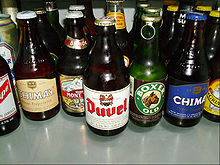Glass bottle: Difference between revisions
Undid revision 383996919 by vandal on 82.198.250.67 (talk), the one spoiling things for the many. |
Aiavd55555 (talk | contribs) No edit summary |
||
| Line 4: | Line 4: | ||
[[Image:Juice bottle.jpg|thumb|right|Glass Juice bottle.]] |
[[Image:Juice bottle.jpg|thumb|right|Glass Juice bottle.]] |
||
Go to www.wethekidsgogreen.pbworks.com :) |
|||
A '''glass bottle''' is a [[bottle]] created from [[glass]]. Glass bottles can vary in size considerably, but are most commonly found in sizes ranging between about 10ml and 5 [[litre]]s. |
A '''glass bottle''' is a [[bottle]] created from [[glass]]. Glass bottles can vary in size considerably, but are most commonly found in sizes ranging between about 10ml and 5 [[litre]]s. |
||
Revision as of 22:06, 5 October 2010


Go to www.wethekidsgogreen.pbworks.com :) A glass bottle is a bottle created from glass. Glass bottles can vary in size considerably, but are most commonly found in sizes ranging between about 10ml and 5 litres.
The history of glass can be traced back to at least 12,000 BC where glass coated objects have been found.[1]
Millions of glass bottles are created worldwide every day. In the US, there is an average of at least 2 bottle-making factories in each county. It is a highly mechanized process, and the bottles in use now are no longer hand blown as they were in the past.[citation needed]
A glass bottle is 100% recyclable with many new bottles containing glass which was created over 20 years ago. Less energy is used in recycling a glass bottle than creating the glass from raw materials, helping the environment.[2]
When glass bottles of liquid are dropped or subjected to shock, the water hammer effect may cause hydrodynamic glass breakage.[3][4]
Glass bottles manufacturing takes place over several stages. To briefly outline the processes from beginning to end: raw material, melting, forming, annealing, physical inspection, machine & laser inspection, physical inspection (second time), quality control, and finally packing.[5]
To strengthen glass bottles, the process of lamination is sometimes done. Laminated safety glass is made by combining a layer of plastic over glass. When a non-laminated bottle is dropped, the glass breaks sending pieces of glass everywhere. When a laminated bottle is dropped, the glass still breaks, though the outer layer of plastic contains the broken pieces of glass.[1]
Once formation is complete, some bottles may suffer from stress as a result of unequal cooling rates. An annealing oven can be used to reheat and cool glass containers to rectify stress and make the bottle stronger. [6]
See also
References
- ^ a b "Glass Information". Retrieved 2008-10-02.
- ^ "Glass Facts" (PDF).
- ^ Saitoh, S (1999). "Water hammer breakage of a glass container". International glass journal. Faenza Editrice,. ISSN 1123-5063.
{{cite journal}}: CS1 maint: extra punctuation (link) - ^
Brandt RC (1994). Fractography of Glass. Plenum Press. ISBN 0-306-44880-7.
{{cite book}}: Unknown parameter|coauthors=ignored (|author=suggested) (help) - ^ "Glass Manufacturing". Retrieved 2008-11-26.
- ^ "How Glass Bottles are Made". Retrieved 2010-03-09.
